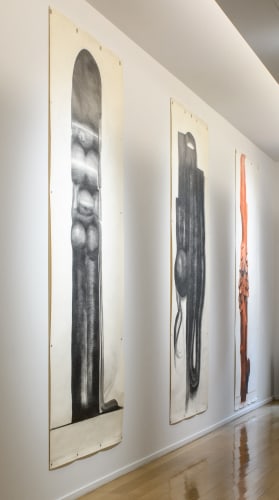Taken as a whole, Fernández’s body of drawings is an expansive repertoire of mark-making techniques: rhythmic, lashing strokes; washes of diffused graphite; and heavily worked, darkened moments, all working to construct mutable and unnamable objects that inhabit the dream-like space of a largely untouched ground.
Born in Cuba in 1928, Fernández received his art education from the Academy of San Alejando in Havana, before attending New York’s Art Students League, where he studied with George Grosz and Yasuo Kuniyoshi.i In 1953, he relocated to Spain where he enrolled in the San Fernando Academy and began to exhibit his work. The year 1959, however, marked an important transition for the artist; not only did he move to Paris on a fellowship from the Cuban government, but his artistic style shifted as well—“I found my true self as a painter at the beginning of the 1960s,” the artist says, “when I was more than thirty years old.”
Fernández’s broad art historical references and interests—from ancient Greek statuary, to flattened Medieval icons, and the liveliness of the Baroque masters— consolidates within his work fruitful and vexing sets of connections. For, if Donald Kuspit finds within Fernández’s paintings and drawings a Surrealist preoccupation with the pre-Oedipal state, it is equally possible to find the influence of Fernández’s heroes, namely the painters Caravaggio and Velázquez. Despite their widely different subjects, Fernández’s work sparks an uncanny formal dialogue with these art historical giants. Exquisitely modeled forms play their part in the orchestration of dramatic movement that threatens to spill from the pictorial surface and invade the space of the viewer. Before a Fernández composition, we feel a similar sense of expectation and curious unease as when standing before Velázquez’s Las Meninas. The latter famously pulls the viewer into its world through compositional complexity and the play of gazes, reversing the traditional relationship of the spectator to the image. Rather than looking through the picture of plane of Las Meninas, one is under the impression that they are being looked at by the painted figures. Likewise, Fernandez’s powerful and mysterious compositions stand apart from the white confines of the paper; they push outward from the picture plane as a sculptural mass, confronting and engaging spectators with uncanny forms.

